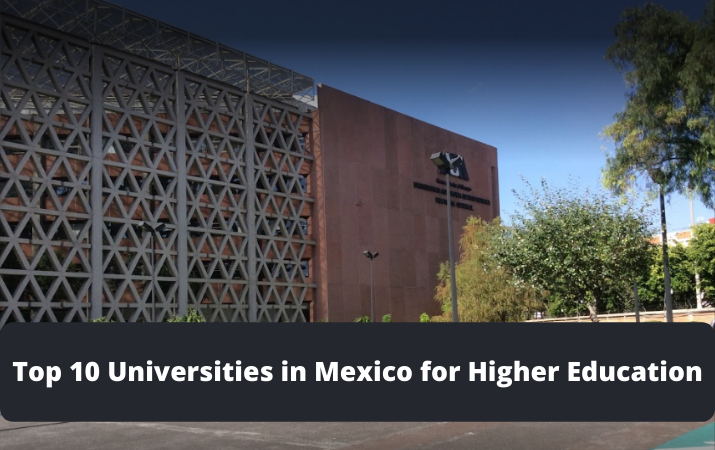Students’ choice of selecting a university abroad depends heavily on employability opportunities. Every year “The Times Higher Education” releases ranking lists for universities around the world. The ranking is based on 13 performance indicators that measure the institution’s performance across teaching, research, knowledge transfer, and international outlook.
The list is prepared after compiling answers of several recruiters, chief executives and business managers from top companies in 20 countries.
Let us have a look at the list “Top 10 Universities in Mexico for Higher Education for the year 2020”
Metropolitan Autonomous University
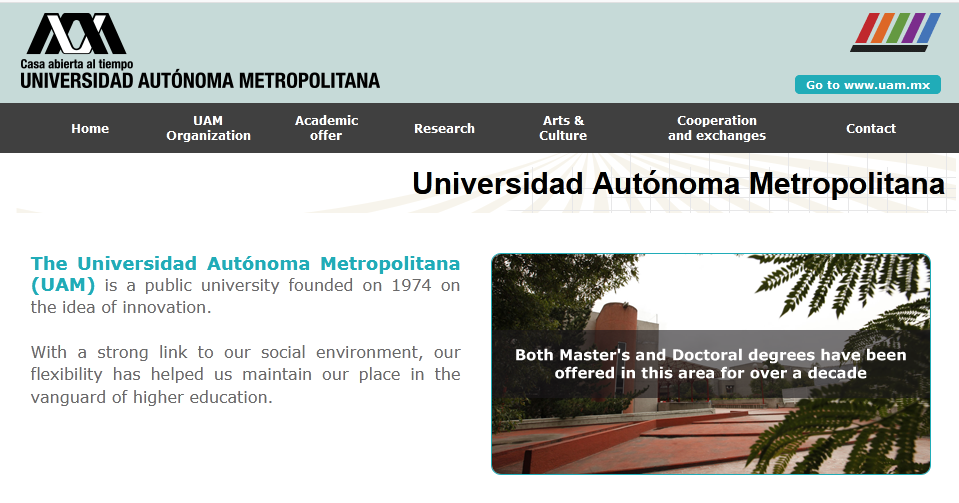
Metropolitan Autonomous University (UAM) was founded in 1974, with the aid of the then-president Luis Echeverria Alvarez. This was one of the establishments implemented after the Tlatelolco massacre in Mexico (1968) and several other movements, all of which called for a national improvement in education and comprehensive education reform.
It is spread over four campuses around Mexico City: Azcapotzalco, Cuajimalpa, Iztapalapa and Xochimilco. The fifth is based in Lerma, a conurbated town near Toluca in the state of Mexico.
Split into six academic divisions: basic sciences and engineering, biological sciences and health, communications sciences and design, natural sciences and engineering, social sciences and humanities and sciences and arts for design, UAM offers 75 undergraduate and 75 postgraduate programs.
As soon as it opened, UAM began offering an undergraduate degree in environmental engineering, making it the first Mexican university to do so.
UAM is implicated in a wide range of social enterprise projects, with the aim of supporting and resolving the problems of Mexican society’s most vulnerable. These include stomatology clinics and legal services for those who cannot afford them, a research and training centre in Chiapas, and the Sierra Nevada Project, with the goal of reconfiguring traditional production practices into sustainable operations that can be maintained long-term.
On-campus facilities and opportunities include foreign language centres, a library, several bookshops, medical centres and sports grounds.
It is highly selective in its admission policy and relies on entrance examinations and past academic records. Between 20-30 per cent of those who apply are accepted to study.
Monterrey Institute of Technology

Tecnológico de Monterrey is a private university system founded in 1943 in Monterrey, México. It is a comprehensive university offering PhD, master, undergraduate, and high-school programs in Engineering, Management, Social, Arts and Human Sciences, and Medicine.
It holds 31 campuses located across 25 cities in the country, and 22 liaison offices in 15 countries. In each campus there are modern and innovative facilities, creating a balance between studying and recreation.
Its academic programs are accredited by international accreditation agencies such as SACS – Southern Association of Colleges and Schools, CACEI – Council for Accreditation of Engineering Education, ABET – Accreditation Board for Engineering and Technology, CACECA – Accreditation Council on the Teaching of Accounting and Administration, AACSB, AMBA, EQUIS, among others. Academic programs are also accredited in Mexico by National Council for Science and Technology CONACYT.
The prestige enjoyed by Tecnológico de Monterrey since its foundation, stemming from the culture of entrepreneurship, work, efficiency and responsibility that it fosters its students, motivated its graduates, who come from diverse regions of Mexico, to promote the presence of Tecnológico de Monterrey in their hometowns. This gave the Institution significant insight into the diverse regional needs, enabling it to prepare professionals who can resolve them, without uprooting them from their hometowns. Moreover, as a nationwide institution, Tecnológico de Monterrey accepts its responsibility to provide a valid response to the country’s foremost challenges.
94% of our graduates are employed with 12 months of graduations and some of Tecnológico de Monterrey’s alumni are now directors in successful companies in Mexico and Latin America, while the presence of its graduates in key government and public administration positions is constantly growing.
Research
At Tecnológico de Monterrey we combine two research approaches with open international collaboration: “knowledge driven creation” and “society driven innovation”. Our researchers have a responsibility towards value creation based on our scientific research that addresses society´s demands.
But they also have to advance scientific knowledge to create new concepts, theories, and paradigms to advance the understanding of the world and the universe. We are committed to undertaking research to educate, innovate and transform in order to transcend in this lifetime. Tecnológico de Monterrey has decided to focus this scientific activity on eight main strategic research areas, encouraging innovation, knowledge generation and knowledge transfer, with the goal of trying to solve México’s and worldwide problems. These eight strategic areas include: biotechnology and food; mechatronics and engineering; information technology, sustainability; public policy; business; medicine; and education, the humanities and the social sciences.
Tecnológico de Monterrey´s research program is based on its flagship campus at Monterrey and operates through six schools constituted by research professors from the research campuses (Tecnológico de Monterrey at Monterrey). The schools are: Business School, School of Social Science and Government, School of Medicine, School of Engineering and Sciences, and the School of Humanities and Education, School of Architecture, Art and Design.
National Autonomous University of Mexico
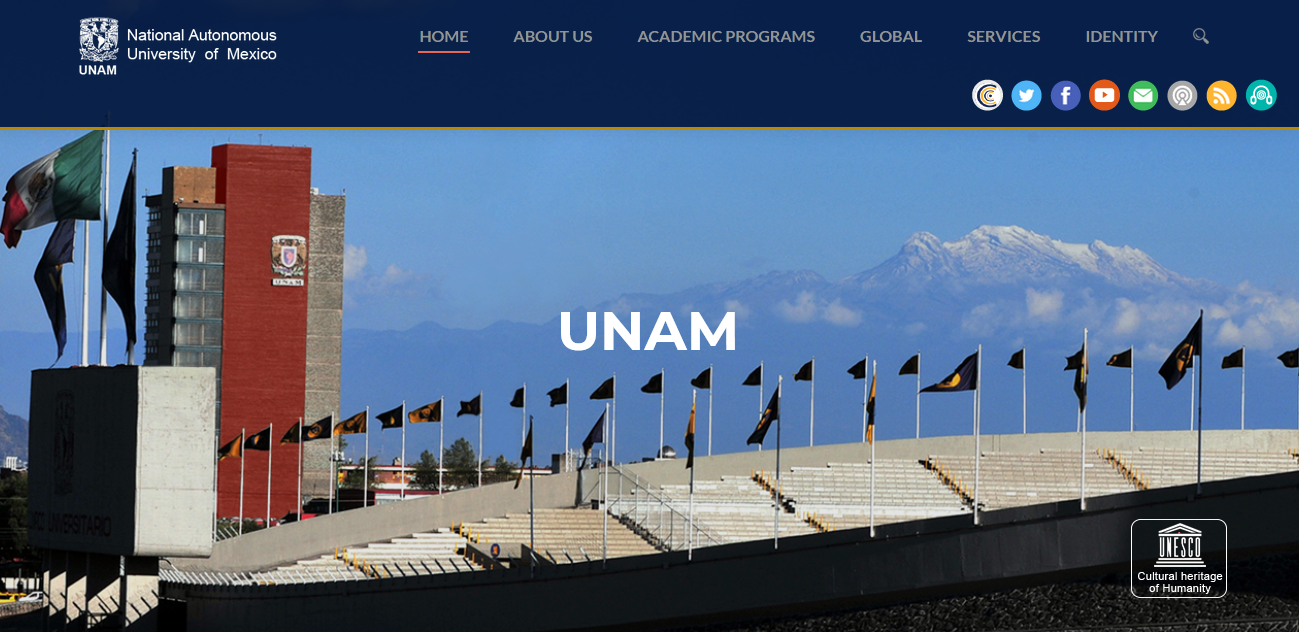
The National Autonomous University of Mexico (NAUM) is the largest university in Latin America. Originally the ‘Royal and Pontifical University of Mexico’, it was founded in 1910 by the then minister of education, Justo Sierra, whose aim was to create a Mexican institute of higher learning based on liberal values.
In 1929 the university was granted autonomy from government influence, which allowed it greater freedoms around curriculum and budgetary management.
Today, as well as offering degrees at undergraduate and postgraduate level, it also runs several high schools throughout Mexico City which prepares students for higher education.
The university’s main campus, designed by some of Mexico’s best architects, is a recognised World Heritage site. Other campuses exist across Mexico and the university also has an international presence in Texas, Illinois and Quebec.
Although university instruction is given in Spanish, most degree programmes include an intensive, five-week Spanish language programme for international students who need to brush up on their language skills.
NAUM has associations with three Nobel Laureates in Peace, Literature and Chemistry. Other notable alumni include no less than five presidents of Mexico and a number of renowned journalists, philosophers and politicians.
The university prides itself on its research excellence and is home to various research centres – including the Centre for Applied Sciences and Technological Development – which emphasise the integration of science with real world problems. NAUM also specialises in conducting research into issues directly relevant to Mexico and the developing world.
Universidad Autónoma de Baja California
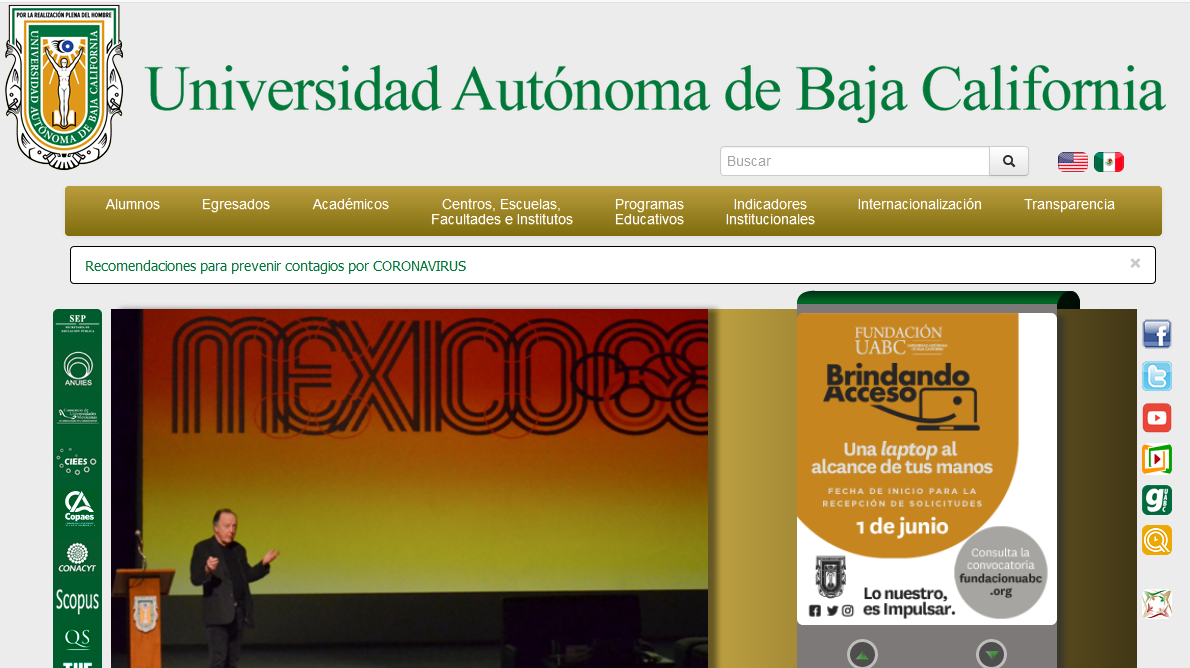
In UABC we promote a variety of options to help our students experience an integral education with a sense of social responsibility for them to participate intensively in a wide range of growth possibilities, such as: a comprehensive tutoring system, internships linked to public and private sectors, cultural and sports activities, entrepreneurship, knowledge dissemination, and community service. We also encourage our students to learn in other languages, and to have life experiences in different cultures, universities and countries.
Autonomous University of Hidalgo State (UAEH)
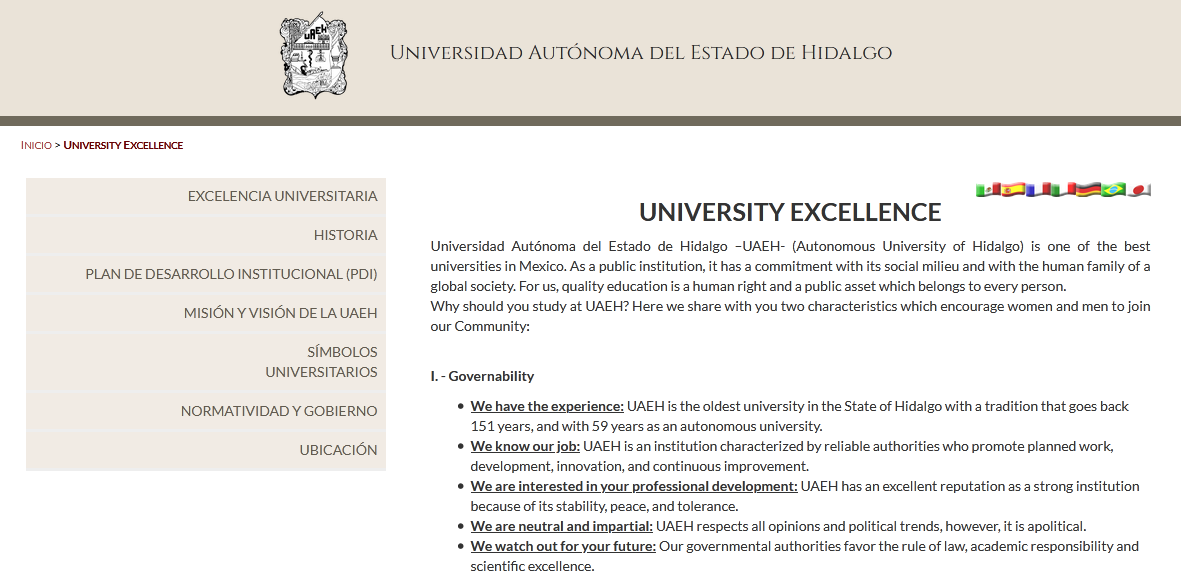
The Universidad Autónoma del Estado de Hidalgo (UAEH) or the Autonomous University of Hidalgo State, began as the Instituto Literario y Escuela de Artes y Oficios (Literary Institute and School of Arts and Crafts) in Pachuca, 1869.
In 1875, it moved to the former San Juan de Dios Hospital (founded in 1725), the structure of which is now the university’s Central Building.
During the Mexican Revolution (1910-17), the university was closed several times but survived. It briefly became known as the University of Hidalgo in 1921, but returned to its original name in 1925.
In the 1940s, programmes in medicine, law and engineering were added and it was granted autonomy in 1948.
UAEH is the oldest and largest university in the state of Hidalgo, Mexico and is known as one of the best universities in Ibero-America and Latin America. It is a member of the Consortium of Mexican Universities (CUMEX) and is one of the best universities in Mexico for postgraduate studies.
It is divided in six faculties in the capital city of Hidalgo, which is named Pachuca. There are also several other campuses located throughout the state of Hidalgo: Actopan, Apan, Atotonilco de Tula, Ciudad Sahagún, Huejutla de Reyes, Minderal del Monte, Tepeií del Río, Tizayuca, Tlahuelilpan, Tulancingo and Zimapán, plus four preparatory schools in the Pachuca region.
The majority of students are from the state capital and state territories. There are also a few international students and students from outside of the state.
Autonomous University of Nuevo León
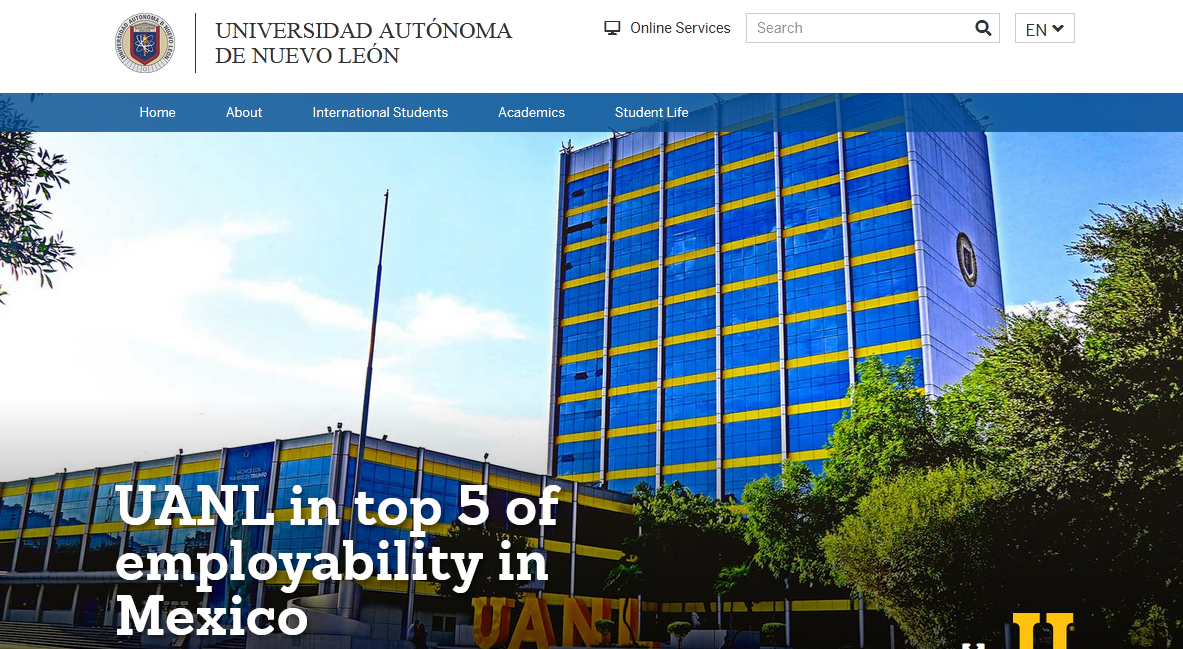
The Autonomous University of Nuevo Leon (UANL) was established in 1933 as a public research university in the Mexican city of San Nicolas de los Garza.
Now the third largest university in Mexico, UANL is organised across seven campuses within the state of Nuevo Leon, including: Ciudad Universitaria, Health Sciences, Mederos, Marin, Agricultural Sciences, Sabinas Hidalgo, and Linares.
Its main campus, known as University City, is home to 153,000 students and 6,394 professors. The campus also houses the bulk of the university’s academic faculties, as well as a 40,000-seat sports stadium, a university hospital and several high schools.
UANL also comprises 37 distinct research centres where more than 500 highly recognised researchers are employed, while the university’s 84 libraries provide students with access to over two million books. Within its 26 faculties, UANL also offers the largest number of academic programmes of any university in northeastern Mexico.
As a public institution strongly, the university prides itself on having a strong social focus, with a commitment to instilling an awareness of regional, national and global issues across its student body.
UANL also extends its learning provision to the community via outreach initiatives by way of helping to preserve the country’s cultural heritage and develop its national wealth.
In terms of recreation, the university football team, Tigres UANL, competes at the highest level of Mexican football, and the university provides a great variety of other activities for students across its campuses. In addition to this, students have easy access to the city of San Nicolas de los Garza, a major industrial city that offers extensive retail facilities and nightlife.
Among the university’s most distinguished alumni are the Olympic gold medallist Raul Gonzalez and several former Nuevo Leon Governors.
Autonomous University of Puebla
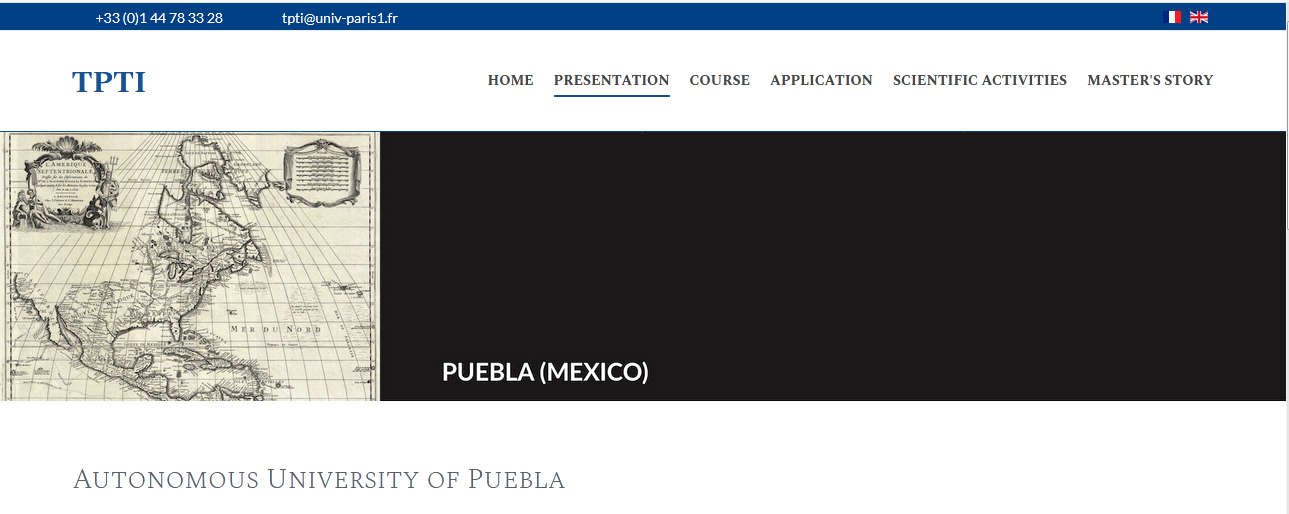
The Autonomous University of Puebla has a long and deeply political history, having been controlled by many different groups over its four centuries of history. It was founded in 1578 when a group of Jesuits settled in the city and built the College of the Holy Spirit.
In the late eighteenth century, political tensions in Spain resulted in the Jesuits being expelled twice. After Mexico gained independence from Spain, the College was renamed as the Imperial College of San Ignacio, St. Jerome and Holy Spirit, then as the State College.
The College established itself as a liberal, humanist hub, and in the early twentieth century, students supported resistance to the dictatorship of President Porfirio Diaz. The College became a University in 1937, and gained full autonomy in 1956, becoming the Meritorious Autonomous University of Puebla (BUAP).
The University continues to espouse liberal values, promoting inclusivity, equal opportunities, human rights and transparency in its mission statement. One of its outdoors spaces is known as ‘Democracy Plaza’.
BUAP has a number of campuses throughout the state of Puebla. Its four major zones in the city of Puebla include the University City – which houses the faculties of physical sciences – and the Health Area, where the Schools of Nursing and Medicine are based. BUAP also has nine regional sections, three near-autonomous ‘foreign academic units’, and six high schools.
A University Cultural Complex hosts regular dance, musical and theatrical events for BUAP students, who also have a radio station, Radio BUAP, and university sports teams, the Lobos BUAP (wolves).
Celebrated intellectuals associated with the university include the polymath Carlos de Siguenza y Góngora, and novelist Ignacio Manuel Altamirano.
Autonomous University of Querétaro
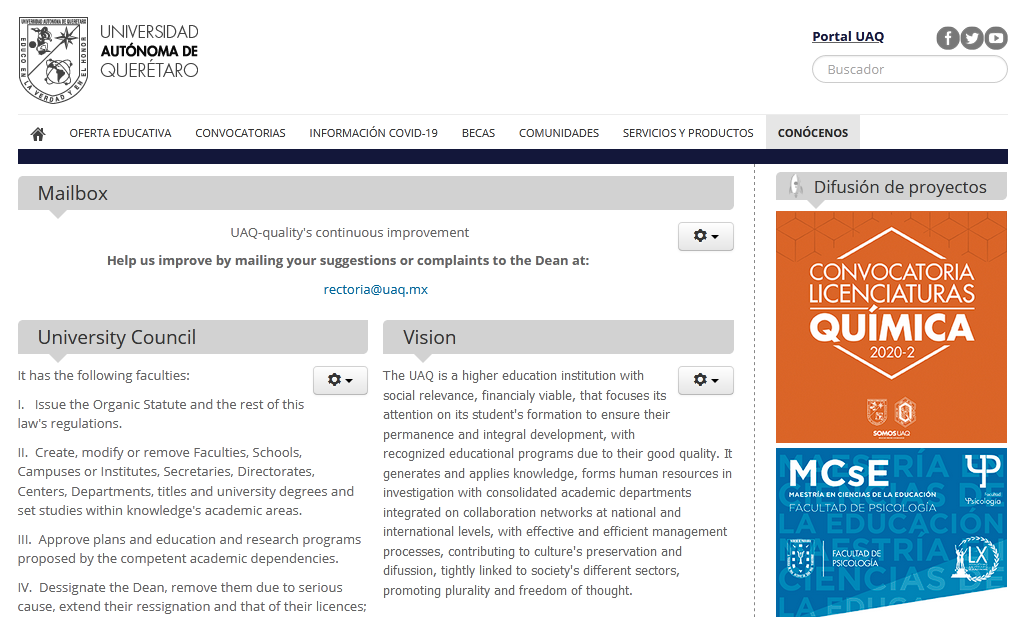
The Autonomous University of Querétaro was established in 1951 by Octavio S. Mondragón in the form of a high school and university that only offered law and engineering degrees, although its origin dates back to 1625, from the Jesuit College of San Ignacio. Since then, the university made several programme additions, whereby in 1952, the school of chemistry and the school of nursing were formed. Later on, in 1953 the Institute of fine Arts was formed, and in 1954 the school of commerce was established.
In 1967 the school of psychology and the school of modern languages were created.
The Cerro de las Campanas campus became the main campus in December 1973.
In 1978, the school of medicine was founded then in 1984 sociology was in introduced. In 1985 veterinary science courses started and in 1978 both the school of informatics (computer science) and the school of philosophy were opened. In 2010 the university opened its new language learning facilities on the grounds of the old Ing. Fernando Espinoza Gutiérrez International Airport.
UAQ has a total of nine campuses located in Cerro de las Campanas, Amealco, Amazcala, Cadereyta, Corregidora, Jalpan, Juriquilla, San Juan del Río, and Tequisquiapan. The university has a total of 13 colleges and six high schools under its administration, which is why their total number of students reached 28,110 in 2016, including over 19,000 undergraduates and almost 2,500 undergraduates.
The school’s motto is “I educate in truth and in honour”, which is why the university has been keen on establishing connections and affiliations to their programmes through membership in the National Association of Universities and Higher Education Institution (ANUIES) in Mexico and the Consortium for North American Higher Education Collaboration (CONAHEC) based in Tucson, Arizona.
Querétaro is a world heritage city where great biodiversity and different ecosystems coexist in the same place. The city offers numerous activities, from mountain expeditions and a tour of the Great Sierra Gorda to relaxing in any of the nearby villages, surrounded by vineyards and cheese makers. Visiting Capuchinas convent and the old cloister of St. Augustine are unforgettable journeys that must be made while studying in this town.
Autonomous University of San Luis Potosi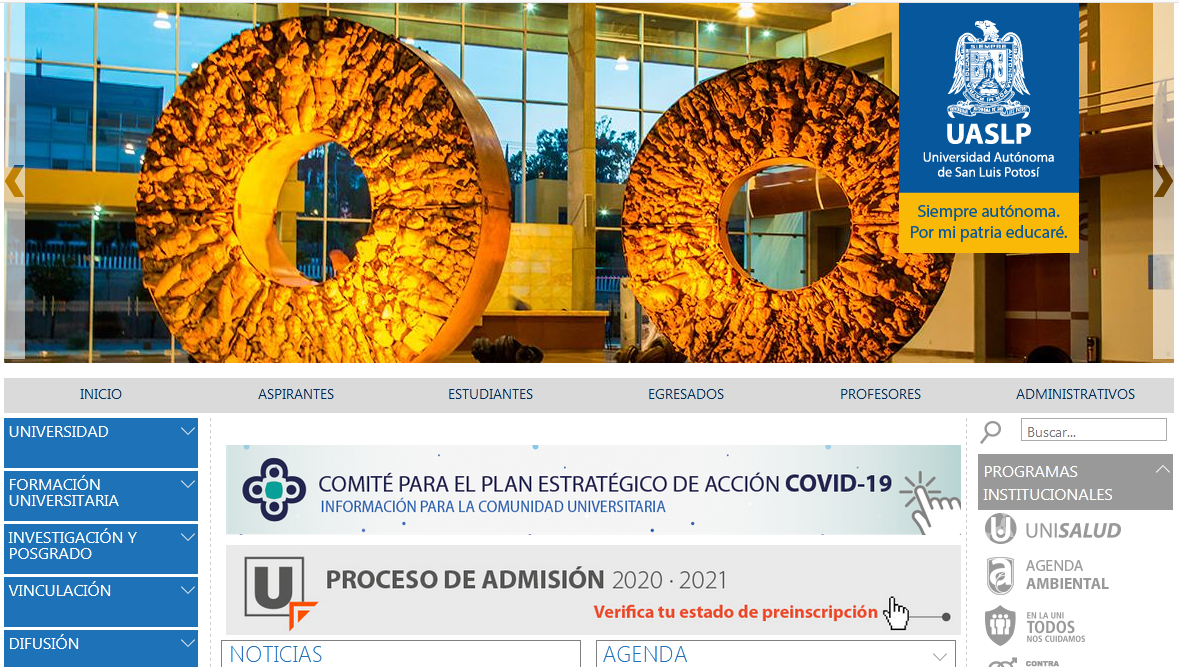
The oldest antecedent of the Autonomous University of San Luis Potosi (UASLP) is a Jesuit college founded in 1624 in the city of San Luis Potosí to teach literacy, secondary and high school studies.
In 1923, governor Rafael Nieto issued a decree that established the university in faculties, schools, coordinations, academic units and departments. Currently it is divided into 15 faculties, one school, four coordinations, one department, seven institutes, 12 research institutes and two academic units.
Both undergraduate and graduate studies are available in each faculty. UASLP has a student population of more than 32,000, and offers 99 undergraduate programmes and 88 postgraduate programmes.
The university has faculties in the following fields: faculty of accounting and administration, agronomy and veterinary, chemistry, communication, economics, engineering, humanities and social sciences, information sciences, law, medicine, nursing and nutrition, psychology, sciences, stomatology and habitat (for architecture, design and building related studies).
UASLP also has branch campuses in the following locations: Ciudad Valles, Ríoverde and Matehuala. Its 12 research institutes are affiliated with the National Association of Universities and Higher Education Institution (ANUIES) in Mexico and the Consortium for North American Higher Education Collaboration (CONAHEC) based in Tucson, Arizona.
Notable alumni include Ponciano Arriaga (1811–1863), lawyer and constitutional congressman and Manuel José Othón (1858–1906), a renowned Mexican poet, politician and playwright. Other more current persona includes Luis Ernesto Derbez, Mexico’s Secretary of Foreign Affairs (2003-2006).
San Luis Potosí is the favorite destination for those seeking fun and adventure in the Huasteca region, it is difficult to not succumb to the beauty of its rivers, the majestic and imposing Sótano de las Golondrinas (Cave of the Swallows), its countless and sublime blue and green waterfalls, the magic of its charming villages, as well as its peaceful sunsets.
The cathedral of St. Luis, the Plaza del Carmen and the Plaza de San Francisco are a must see. The capital itself has a beautiful, historic city centre, declared a World Heritage Site by UNESCO in 2010.
Autonomous University of Sinaloa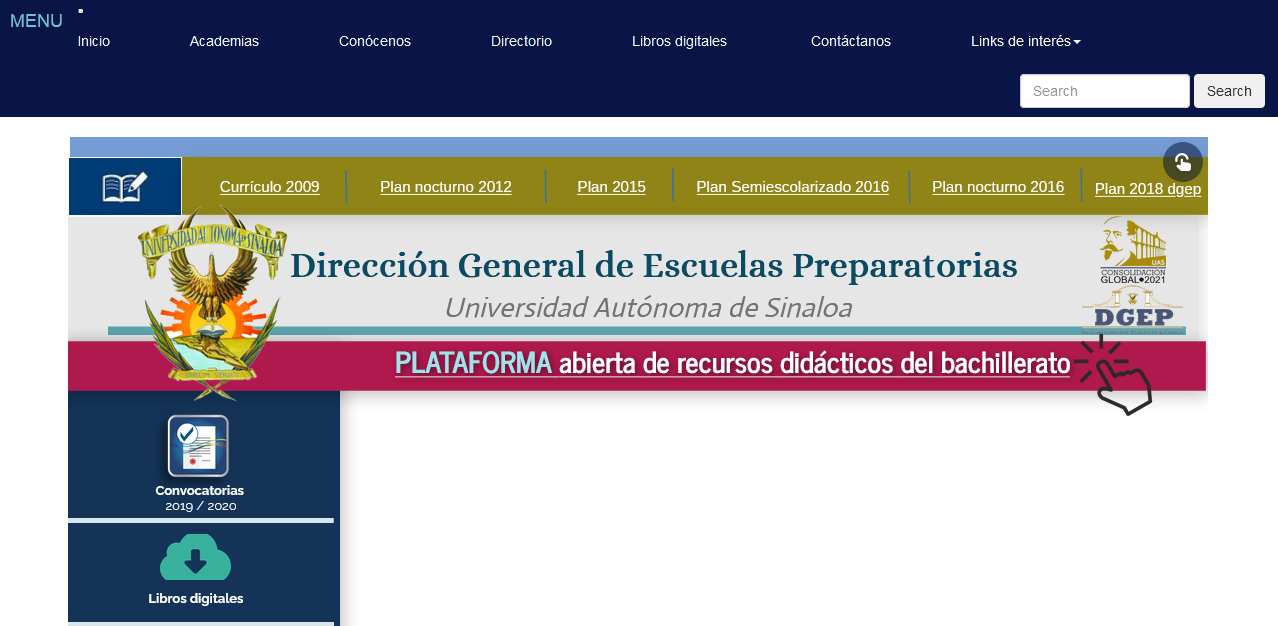
The Autonomous University of Sinaloa (UAS) is a public university founded in 1873 in Sinaloa, Mexico.
UAS has more than 40 undergraduate programmes, 40 master’s and 12 PhD programmes including agronomy engineering, business and international trade, chemical and biological engineering, computer science, dentistry, education, gastronomy, English language teaching, surveying engineering, history, journalism, nutrition, optometry, public policy, social work and veterinary medicine and zootechnics to name but a few.
Located in northwest Mexico, the university has five campuses situated along northern, mid-northern, central and southern Sinaloa. With a population of 128,077 students, the university is considered to be the leading academic institution in regard to having the most encompassing coverage in the region.
The university is renowned for having quality academic conduct and governing systems, in addition to accreditations and certifications from agencies with national and international recognition including universities and institutions from South America, China, Russia, Spain, and the USA.
UAS also has an entrepreneurship and innovation centre that has been created to strengthen the creative abilities and leadership skills of young entrepreneurs and support innovative business projects.
Famous for its band music and several thousand-year-old games known as ulama, the state is filled with both cultural and historical attractions. Its position on the sea makes it popular among vacationers. Its most popularly visited city is Mazatlan, a coastal resort town known for its beaches of lustrous white sand and spectacular surfing. Santa Maria Island and its surrounding islands are also noted tourist destinations. Many people take up fishing while there and catch mahi-mahi, sailfish, and swordfish. There are also cultural and historical attractions throughout the state. Sinaloa’s capital, Culiacan Rosales, is also its largest city.
Follow us on Facebook, Twitter, LinkedIn.








